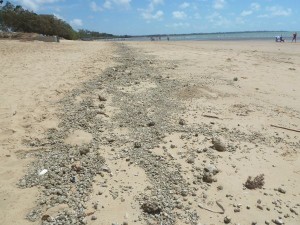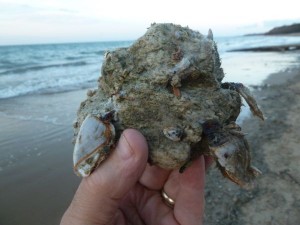
I’m in Hervey Bay on holidays and the high tide mark on the beach is littered with pumice. Most is the size of coarse gravel; some pieces are as big as a tennis ball; a few chunks are as big as a football.
The pumice began arriving in northern New South Wales and Southern Queensland in March, 2013, and more recently in north Queensland from Cairns to the Torres Strait in September.
The fragments are rounded and have been colonised by a marine micro-community. Scott Bryan, a researcher with the Queensland University of Technology has identified the pumice has carried barnacles, molluscs, anemones, bristle worms, hydroids and crabs. Algae are also growing on the pumice.
The pumice has travelled some 4,000 km from the Havre Seamount in the Kermadac Islands, which lie about 1000 km north of New Zealand. In July 2012, a volcano on that seamount erupted under the ocean, creating an enormous volume of pumice that floated on the ocean like a raft.

Soon after the eruption, a pumice raft was observed on the ocean in the area, a monstrous 500 km long and 50 km wide—about the size of Belgium. The top of the raft sat some 2 feet (0.6 m) above the water and appeared brilliant white in a spotlight, like the edge of an ice shelf.
Since the eruption, the raft has broken up and dispersed, and the pumice has travelled thousands of kilometres across the ocean.
This illustrates how a catastrophic event can produce material that will travel long distances.
It reminded me of the concept Gondwanaland.
Scientists have long recognized that the southern continents, South Africa, Australia, New Zealand, Antarctica and South America, have similar vegetation, referred to as Gondwana vegetation. To explain these similarities, most scientists say that the continents were once connected together into one supercontinent called Gondwanaland. During the Mesozoic this super-continent broke apart and the continental fragments carried the vegetation to different parts of the globe.
However, we can see from what happened to the pumice that there could be a simpler explanation, one that does not involve moving vast continents tens of thousands of kilometres. Instead, it simply needs to move the vegetation across the ocean.
Noah’s Flood was an unimaginably large global catastrophe, much larger than the eruption of the volcano on Havre Seamount. As a result of that catastrophe the vegetation that was growing on the pre-Flood continents was ripped up. Much of it would have floated in enormous rafts on the ocean, similar to the pumice raft, except for one big difference. The vegetation raft would have been much, much larger.
Here is the scenario. The vegetation on the southern continents is similar because similar vegetation was ripped up and floated across the southern ocean and was buried on the different continents. This vegetation was carried to the different continents, not by moving continents, but by moving ocean currents.
It’s an idea I think that’s worth exploring.
Sandra Lippiatt
In the last fortnight, I have seen pumice on the beach at Wynnum, Brisbane and much larger pieces at Caves/Hams Beach near Swansea, NSW. 10 December 2013. Much larger pieces in NSW.
John Kerr
I agree that pumice rafts are amazing, and colonise ocean-to-ocean (goose barnacles worldwide), and make landfalls sometimes too. Today’s marine iguanas of the Galapagos Islands were descended from American land iguanas that presumably got carried there by raft, one with some vegetation on it as well as, perhaps, pumice. But it would be foolish to dismiss the abundant evidence of continental drift and ascribe all colonisation to pumice rafts. Noah’s flood is an old local myth, probably based on a Black Sea inundation event.
Tas Walker responds:
No, the Black Sea hypothesis you mention was not the Flood of Noah. Check out: The Black Sea flood: Definitely not the Flood of Noah, and The Black Sea flood may evaporate completely.